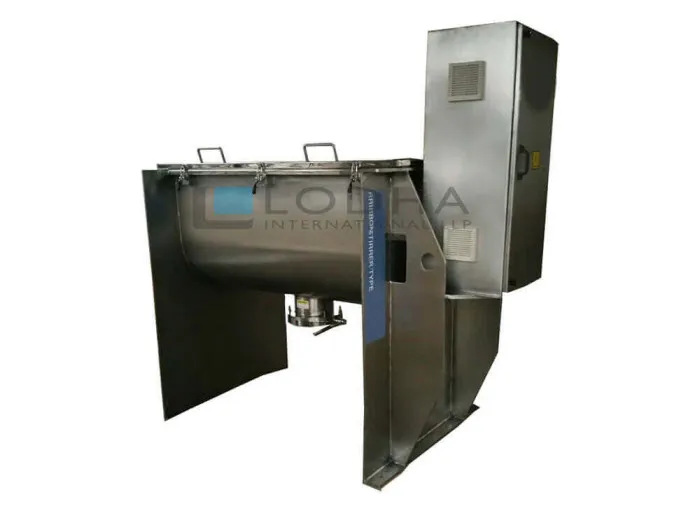Get in touch! +91 9687731331 | +91 9687631331 | info@lodhapharma.com
Ribbon Blender Maintenance Tips for Optimal Performance
Ribbon blenders are widely used in various industries for mixing powders and granular materials. However, like any other machine, they require proper maintenance to ensure optimal performance and longevity. Neglecting routine maintenance can lead to costly repairs, downtime, and even safety hazards.
Ribbon blenders are a well-proven technology for efficient powder mixing. They feature a U-shaped horizontal trough with a double helical ribbon agitator rotating within. The outer ribbon has a precise pitch that moves material radially, while the inner ribbon has an opposing movement ability that sends material towards the discharge opening. This alternating movement promotes thorough mixing and helps prevent product migration during changeovers.
Importance of Regular Maintenance
Regular maintenance is crucial for the smooth operation and long-term performance of ribbon blenders. Without proper maintenance, several problems can occur, such as material buildup, bearing failure, motor overload, and seal leakage. These issues can lead to reduced efficiency, increased energy consumption, and even safety hazards. Therefore, it's essential to follow a maintenance schedule and perform routine inspections to identify and fix any potential problems before they escalate.
Clean the Blender after Every Use
Ribbon Blender (also called ribbon mixer) is a basic industrial mixing machine consisting of a trough-shaped shell, usually two to three times longer than it is wide.
Cleaning the blender after every use is essential to prevent material build-up, contamination, and corrosion. Use a soft-bristle brush, a vacuum cleaner, or compressed air to remove any residual material from the trough, agitator, and discharge valve. Also, wipe the surfaces with a clean, dry cloth or a mild detergent solution. Avoid using abrasive materials or harsh chemicals that can damage the equipment.
A horizontal agitator shaft runs through the center of the trough, and it is fitted with a pair of helical ribbons on either side. The outer ribbon has a pitch that moves material towards the discharge opening, and the inner ribbon has an opposing pitch that moves it away from it.

Clean the Agitator of Ribbon Blender
The agitator of a Ribbon Blender is the part that mixes the material inside the jar. Often, the agitator consists of metal ribbons that are twisted and balanced to continually transfer material inside the trough.
A ribbon blender consists of a U-shaped horizontal trough and a specially fabricated agitator that contains inner and outer helical blades. These blades move the material axially, in opposite directions and radially to promote the thorough blending of materials in short cycle times.
This combination is ideal for blending powdered and bulk solids, especially when the material has shear sensitivity. However, it is important to keep in mind that these mixers can only handle a certain amount of loading.
Check the Seals of Ribbon Blender
The seals prevent material leakage from the trough and protect the bearings and drive system from contamination. Inspect the seals regularly for signs of wear, cracks, or leaks. Replace any damaged or worn seals immediately to prevent material leakage and bearing failure. Also, make sure that the seals are correctly installed and aligned.
When a ribbon blender is running, keeping the shaft inside the mixing tank sealed is important. This helps prevent contamination from the outside, prolongs the life of the blender's bearings and avoids product leakage that can result in machine failure.
A rotary shaft seal can be applied on one or both ends of the shaft depending on your specific ribbon blender. These specialized shaft seals can be installed easily and are designed to help prevent product leakage.
A properly-maintained ribbon blender can ensure the efficiency and productivity of your operation. It also reduces downtime and increases your productivity while minimizing costs. These ribbon mixer maintenance tips are the best way to keep your ribbon blender performing at its peak.

Monitor the Motor and Electrical Components
The motor and electrical components of the ribbon blender are critical to its operation and require regular monitoring. Start by checking the motor for any signs of overheating or unusual noise. Inspect the electrical components, such as switches, fuses, and wiring, for signs of damage or wear. Ensure the wiring is properly grounded and all connections are tight and secure. If you notice any issues with the motor or electrical components, contact a qualified technician for further inspection and repairs. Neglecting these components can lead to costly repairs, downtime, and even safety hazards. Therefore, it's essential to include them in your routine maintenance schedule and monitor them regularly to ensure optimal performance and longevity of your ribbon blender.
Ribbon blenders are used for a wide range of industrial applications from food processing to making chemical mixtures and dry cleaning powders. The basic design consists of a horizontal trough with a shaft through the middle that contains mixing blades or “ribbons” that rotate inside.
These ribbons transfer shear between the product and the agitator, which helps mix the ingredients. These ribbons can be agitated by paddles, blades or ploughs and come in different designs with variations in the number and type of blades or ribbons used.
For optimum performance, ribbon blenders should be cleaned properly and regularly to prevent residue from building up and causing contamination issues in your production. For this reason, CIP (cleaning in place) cleaning of ribbon blenders can be done efficiently and thoroughly using either impingement or rotary jet head cleansers.
Lubricate the Bearings Regularly
Lubricating the bearings regularly is crucial to prevent premature wear and tear, overheating, and failure. Check the bearings every month and add lubricant as needed. Use a high-quality grease that is compatible with the bearing material and operating conditions. Over-lubrication can be as harmful as under-lubrication, so make sure to follow the recommended amount.

